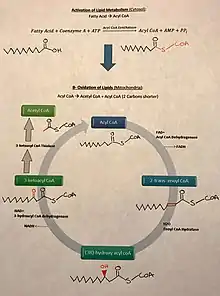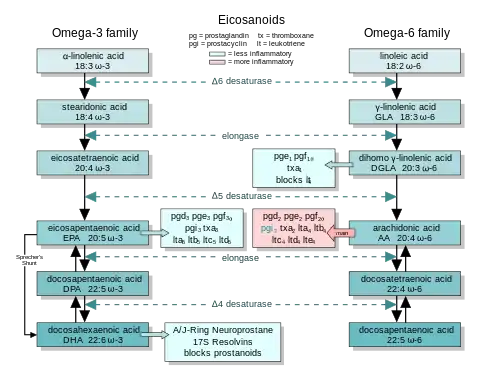Essential fatty acid interactions
In chemistry, particularly in biochemistry, a fatty acid is a carboxylic acid with an aliphatic chain, which is either saturated or unsaturated. The two essential fatty acids are omega-3 and omega-6, necessary for good human health. However, the effects of the ω-3 (Omega-3) and ω-6 (Omega-6) essential fatty acids (EFAs) are characterized by their interactions. The interactions between these two fatty acids directly affect the signaling pathways and biological functions like inflammation, protein synthesis, neurotransmitters in our brain, and metabolic pathways in the human body.

Arachidonic acid (AA) is a 20-carbon omega-6 essential fatty acid.[1] It sits at the head of the "arachidonic acid cascade," which initiates 20 different signaling paths that control various biological functions, including inflammation, cell growth, and the central nervous system.[2][3] Most AA in the human body is derived from dietary linoleic acid (18:2 ω-6), found in nuts, seeds, vegetable oils, and animal fats.[4][5][6]
During inflammation, two other groups of dietary essential fatty acids form a cascade that competes with the arachidonic acid cascade. EPA (20:5 ω-3) provides the most important competing cascade. EPA is ingested from oily fish, algae oil, or alpha-linolenic acid (derived from walnuts, hemp oil, and flax oil). DGLA (20:3 ω-6) provides a third, less prominent cascade. It is derived from dietary GLA (18:3 ω-6) found in borage oil. These two parallel cascades soften the inflammatory-promoting effects of specific eicosanoids made from AA.
The diet from a century ago had much less Omega-3 than the diet of early hunter-gatherers, but also much less pollution than today,[7] which evokes the inflammatory response. These changes accompany increased rates of diseases—known as diseases of civilization—involving inflammatory processes. There is now very strong evidence[8] that several conditions are ameliorated by increasing dietary ω-3. More preliminary evidence shows that dietary ω-3 can ease symptoms in several psychiatric disorders.[9]
Eicosanoid series nomenclature
Eicosanoids are signaling molecules derived from the essential fatty acids (EFAs); they are a significant pathway by which the EFAs act in the body. There are four classes of eicosanoid and two or three series within each category.
The plasma membranes of cells contain phospholipids composed of a hydrophilic phosphate head and two hydrophobic fatty acid tails. Some of these fatty acids are 20-carbon polyunsaturated essential fatty acids (AA, EPA, or DGLA). [citation needed] In response to various inflammatory signals, these EFAs are cleaved out of the phospholipid and released as free fatty acids. Next, the EFA is oxygenated (by either of two pathways) and further modified, yielding the eicosanoids. [citation needed] Cyclooxygenase (COX) oxidation removes two C=C double bonds, leading to the TX, PG, and PGI series. Lipoxygenase oxidation removes no C=C double bonds and leads to the LK.[1]
After oxidation, the eicosanoids are further modified, making a series. Members of a series are differentiated by a letter and are numbered by the number of double bonds, which does not change within a series. For example, cyclooxygenase action upon AA (with four double bonds) leads to the series-2 thromboxanes[2] (TXA2, TXB2... ), each with two double bonds. Cyclooxygenase action on EPA (with five double bonds) leads to the series-3 thromboxanes (TXA3, TXB3, etc.), each with three double bonds. There are exceptions to this pattern, some of which indicate stereochemistry (PGF2α).
Table (1) shows these sequences for AA (20:4 ω-6). The sequences for EPA (20:5 ω-3) and DGLA (20:3 ω-6) are analogous.
| Dietary Essential Fatty Acid |
Abbr | Formula carbons:double bonds ω |
Eicosanoid product series | ||
|---|---|---|---|---|---|
| TX PG PGI |
LK | Effects | |||
| Gamma-linolenic acid via Dihomo gamma linolenic acid |
GLA DGLA |
18:3ω6 20:3ω6 |
series-1 | series-3 | less inflammatory |
| Arachidonic acid | AA | 20:4ω6 | series-2 | series-4 | more inflammatory |
| Eicosapentaenoic acid | EPA | 20:5ω3 | series-3 | series-5 | less inflammatory |
All prostanoids are substituted prostanoic acids. Cyberlipid Center's Prostenoid page[1] illustrates the parent compound and the rings associated with each series letter.
The IUPAC and the IUBMB use the equivalent term icosanoid.[1]
Arachidonic acid cascade in inflammation

In the arachidonic acid cascade, dietary linoleic acid (18:2 ω-6) is desaturated and elongated to form arachidonic acid (and other omega-6 acids), which is then esterified into a phospholipid in the cell membrane.[1] Next, in response to many inflammatory stimuli, such as air pollution, smoking, second-hand smoke, hydrogenated vegetable oils, and other exogenous toxins, phospholipase is generated and cleaves this phospholipid, releasing AA as a free fatty acid. [citation needed] AA can then be oxygenated and modified to form eicosanoids—autocrine and paracrine agents that bind receptors on the cell or its neighbours to alert the immune system of cell damage. Alternatively, AA can diffuse into the cell nucleus and interact with transcription factors to control DNA transcription for cytokines or other hormones.
Mechanisms of ω-3 eicosanoid action

Eicosanoids from AA promote inflammation. Those from GLA (via DGLA) and from EPA are generally less inflammatory, inactive, or anti-inflammatory. (This generalization is qualified: an eicosanoid may be pro-inflammatory in one tissue and anti-inflammatory in another. (See discussion of PGE2 at Calder[1] or Tilley.[2])
Figure 2 shows the ω-3 and -6 synthesis chains and the significant eicosanoids from AA, EPA, and DGLA.
Dietary ω-3 and GLA counter the inflammatory effects of AA's eicosanoids in three ways: displacement, competitive inhibition, and direct counteraction.
Displacement
Dietary ω-3 decreases tissue concentrations of AA. Animal studies show increased dietary ω-3 decreases AA in the brain and other tissues.[3] alpha-Linolenic acid (18:3 ω-3) contributes by displacing linoleic acid (18:2 ω-6) from the elongase and desaturase enzymes that produce AA. EPA inhibits phospholipase A2's release of AA from the cell membrane.[4] Other mechanisms involving the transport of EFAs may also play a role.
The reverse is true: high dietary linoleic acid decreases the body's conversion of α-linolenic acid to EPA. However, the effect is not as strong; the desaturase has a higher affinity for α-linolenic acid than linoleic acid.[5]
Competitive Inhibition
DGLA and EPA compete with AA for access to the cyclooxygenase and lipoxygenase enzymes. So, the presence of DGLA and EPA in tissues lowers the output of AA's eicosanoids. For example, dietary GLA increases tissue DGLA and lowers TXB2.[6][7] Likewise, EPA inhibits the production of series-2 PG and TX.[1] Although DGLA does not form LTs, a DGLA derivative blocks the transformation of AA to LTs.[8]
Counteraction
Some DGLA and EPA-derived eicosanoids counteract their AA-derived counterparts. For example, DGLA yields PGE1, which powerfully compensates PGE2.[9] EPA yields the antiaggregatory prostacyclin PGI3 [10]. It also causes the leukotriene LTB5, which vitiates the action of the AA-derived LTB4.[11]
The paradox of dietary GLA
Studies have shown that dietary oxidized linoleic acid (LA, 18:2 ω-6) has inflammatory properties. In the body, LA desaturates to form GLA (18:3 ω-6), yet dietary GLA is anti-inflammatory. Some observations partially explain this paradox: LA competes with α-linolenic acid (ALA, 18:3 ω-3) for Δ6-desaturase and thereby eventually inhibits the formation of anti-inflammatory EPA (20:5 ω-3). In contrast, GLA does not compete for Δ6-desaturase. GLA's elongation product, DGLA (20:3 ω-6), competes with 20:4 ω-3 for the Δ5-desaturase and is expected that this would make GLA inflammatory, but it is not, perhaps because this step isn't rate-determining. Δ6-desaturase does appear to be the rate-limiting step; 20:4 ω-3 does not significantly accumulate in bodily lipids.
DGLA inhibits inflammation through competitive inhibition and direct counteraction (see above). Dietary GLA leads to sharply increased DGLA in the white blood cells' membranes, whereas LA does not. This may reflect white blood cells' lack of desaturase. Supplementing dietary GLA increases serum DGLA without increasing serum AA.[9][12]
It is likely that some dietary GLA eventually forms AA and contributes to inflammation. Animal studies indicate that the effect is small.[7] The empirical observation of GLA's results argues that DGLA's anti-inflammatory effects dominate.[13]
The Complexity of Pathways
Eicosanoid signaling paths are complex. It is, therefore, difficult to characterize the action of any particular eicosanoid. For example, PGE2 binds four receptors, dubbed EP1–4. A separate gene codes each, and some exist in multiple isoforms. Each EP receptor, in turn, couples to a G protein. The EP2, EP4, and one isoform of the EP3 receptors couple to Gs. This increases intracellular cAMP and is anti-inflammatory. EP1 and other EP3 isoforms couple to Gq. This leads to increased intracellular calcium and is pro-inflammatory. Finally, yet another EP3 isoform couples to Gi, decreasing cAMP and increasing calcium. Many immune system cells express multiple receptors that couple these opposing pathways.[2] Presumably, EPA-derived PGE3 has a somewhat different effect on this system but is not well characterized.
The arachidonic acid cascade in the Central Nervous System (CNS)
The arachidonic acid cascade is arguably the most elaborate signaling system neurobiologists have to deal with.
Daniele Piomelli Arachidonic Acid[2]
The arachidonic acid cascade proceeds somewhat differently in the brain. Neurohormones, neuromodulators, or neurotransmitters act as first messengers. They activate phospholipids to release AA as a free fatty acid from neuron cell membranes. [citation needed] Free AA may affect the activity of the neuron's ion channels and protein kinases during its short lifespan. Or it may be metabolized to form eicosanoids, epoxyeicosatrienoic acids (EETs), neuroprotectin D, or various endocannabinoids (anandamide and its analogues).
The actions of eicosanoids within the brain are not as well characterized as they are in inflammation. Studies suggest that they act as second messengers within the neuron, possibly controlling presynaptic inhibition and the activation of protein kinase C. They also act as paracrine mediators, acting across synapses to nearby cells. The effects of these signals are not well understood. (Piomelli, 2000) states that there is little information available.
Neurons in the CNS are organized as interconnected groups of functionally related cells (e.g., in sensory systems). A diffusible factor released from a neuron into the interstitial fluid and able to interact with membrane receptors on adjacent cells would be used to "synchronize" the activity of an ensemble of interconnected neural cells. Furthermore, during development and in certain forms of learning, postsynaptic cells may secrete regulatory factors that diffuse back to the presynaptic component, determining its survival as an active terminal, the amplitude of its sprouting, and its efficacy in secreting neurotransmitters—a phenomenon known as retrograde regulation. Studies have proposed that arachidonic acid metabolites participate in retrograde signaling and other local modulation of neuronal activity.
| Arachidonic Acid Cascade | ||
|---|---|---|
| In inflammation | In the brain | |
| Major effect on | Inflammation in tissue | Neuronal excitability |
| AA released from | White blood cells | Neurons |
| Triggers for AA release | Inflammatory stimuli | Neurotransmitters, neurohormones and neuromodulators |
| Intracellular effects on | DNA transcription of cytokines and other mediators of inflammation |
Activity of ion channels and protein kinases |
| Metabolized to form | Eicosanoids, resolvins, isofurans, isoprostanes, lipoxins, epoxyeicosatrienoic acids (EETs) |
Eicosanoids, neuroprotectin D, EETs and some endocannabinoids |
The EPA and DGLA cascades are also present in the brain, and their eicosanoid metabolites have been detected. The effects of EPA and DGLA cascades on mental and neural processes are not as well characterized as their effects on inflammation.
Further discussion
Figure 2 shows two pathways from EPA to DHA, including the exceptional Sprecher's shunt.
5-LO acts at the fifth carbon from the carboxyl group. Other lipoxygenases—8-LO, 12-LO, and 15-LO—make other eicosanoid-like products. To act, 5-LO uses the nuclear-membrane enzyme 5-lipoxygenase-activating protein (FLAP), first to a hydroperoxyeicosatetraenoic acid (HPETE), then to the first leukotriene, LTA.
See also
References
- Cyberlipid Center. "Prostanoids". Archived from the original on February 8, 2007. Retrieved February 11, 2006.
- Piomelli, Daniele (2000). "Arachidonic Acid". Neuropsychopharmacology: The Fifth Generation of Progress. Archived from the original on 2006-07-15. Retrieved 2006-03-03.